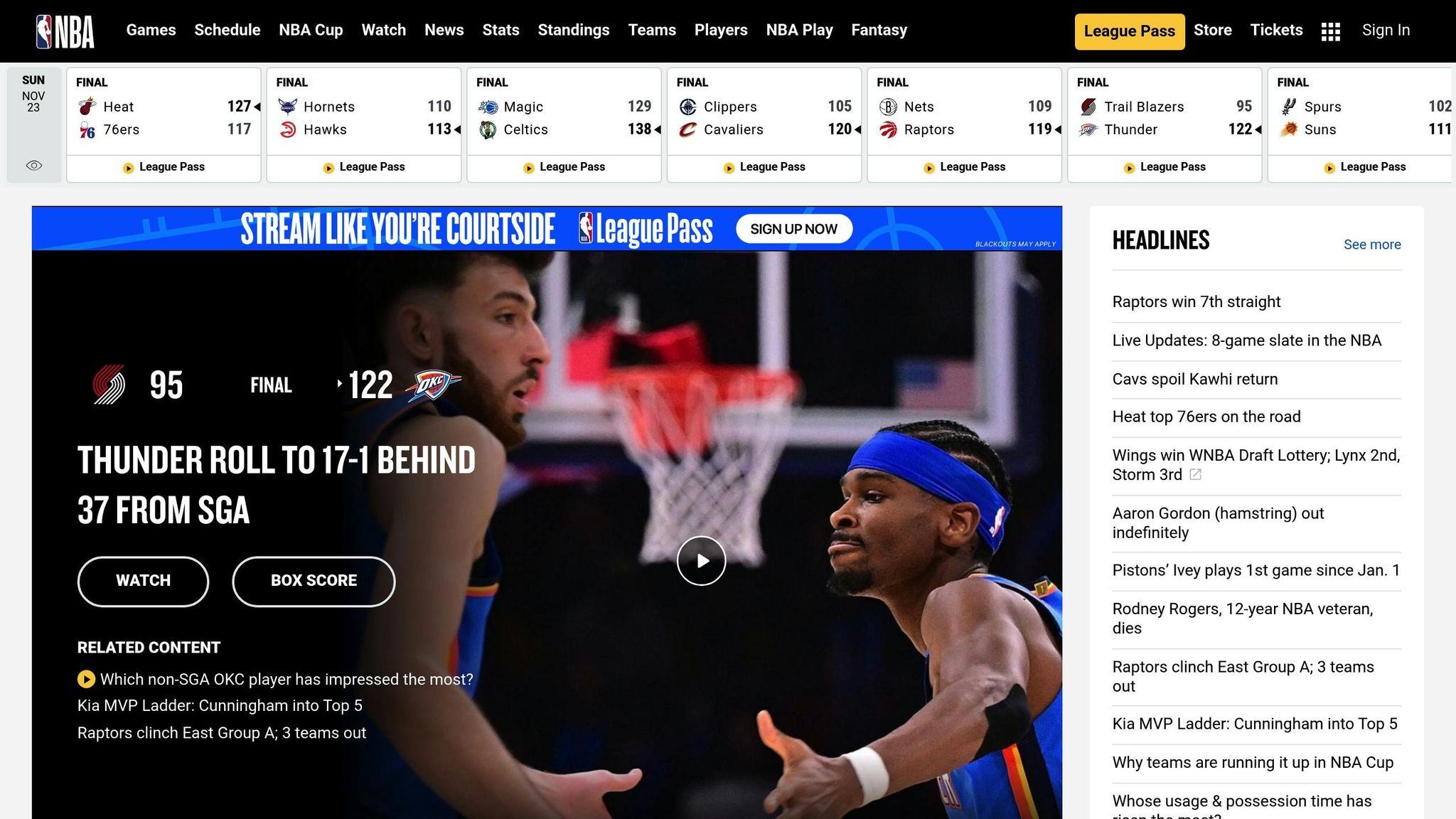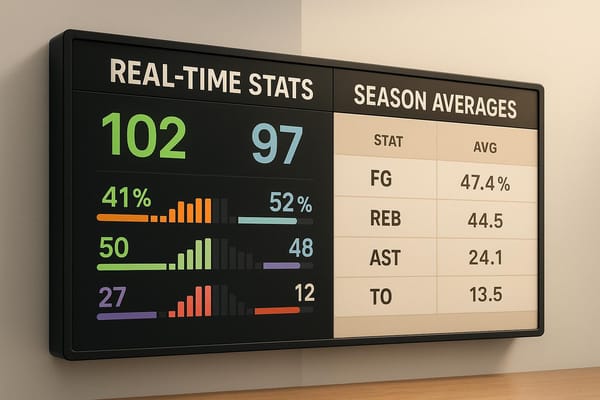NBA Stars and Injuries: Historical Data Analysis
Injury trends in the NBA reveal the impact on player performance, career longevity, and team success, highlighting the importance of injury prevention strategies.

Injuries have reshaped the NBA, sidelining star players and altering team outcomes. Over the past decades, missed games due to injuries have surged - star players missed an average of 24 games per season in the 2010s compared to just 10.6 games in the 1990s. Achilles ruptures, ACL tears, and knee issues dominate career-altering injuries, with 39% of Achilles-injured players never returning to the court. Even those who do often struggle - only 37% regain pre-injury performance levels within a year.
Key injury stats:
- 59,179 games missed over 17 years due to injuries.
- Most common injuries: Lateral ankle sprains (13.2%), patellofemoral inflammation (17.5% of missed games).
- Rookies face a higher injury risk, particularly ankle injuries, at rates 1.43 times higher than veterans.
- Recovery challenges: Severe injuries like Achilles ruptures require 9–12 months, with low return rates.
Teams are now using tools like StatPro for injury prevention, analyzing player workloads, and crafting tailored recovery plans. These measures aim to reduce injury risks, though the cumulative toll of injuries still shortens careers and impacts long-term health. Stories like Derrick Rose and Yao Ming highlight how injuries derail careers, while rare comebacks like De'Aaron Fox’s show recovery is possible. Ultimately, managing player health is as critical to success as on-court strategy.
What's behind the NBA's injury CRISIS? | The Big Number

NBA Injury Data: Patterns and Trends Over Time
Over the years, NBA injury data has revealed shifting patterns that directly affect player careers and team strategies. By studying these trends, we gain a clearer picture of the physical demands placed on athletes in today’s game.
Most Frequent NBA Injuries and Their Causes
Lateral ankle sprains are the most common injury in the NBA, making up 13.2% of all recorded injuries over a 17-year period. The fast-paced nature of basketball, with constant cutting and jumping, makes players particularly prone to this type of injury.
Patellofemoral inflammation, a knee condition caused by repetitive jumping and landing on hard courts, ranks second. It accounts for 11.9% of injuries and is responsible for 17.5% of all missed games - roughly 10,370 games lost during the study period.
Other frequently reported injuries include lumbar strains (7.9%) and hamstring strains (3.3%). These injuries are often linked to the explosive movements required in basketball, such as quick sprints, sharp stops, and rapid changes in direction.
These figures highlight how the physical demands of the game contribute to injury trends that evolve over time.
How Injury Rates Have Shifted Over the Decades
NBA injury rates have risen noticeably over the years. For example, game-related injuries increased by 12.4% over a 10-year span. This uptick is attributed to factors like larger, faster players, more physical gameplay, and advancements in diagnostic technology that make injuries easier to detect and report.
| Era Comparison | Average Games Missed by Stars | Key Differences |
|---|---|---|
| 1990s | 10.6 games per season | Fewer injuries and a less physically demanding playing style |
| 2020s | 24 games per season | 127% rise in missed games compared to the 1990s |
This increase in missed games underscores how modern playing styles and improved diagnostics have reshaped the game. For instance, in the 2023–24 season alone, seven Achilles tendon ruptures were reported - far exceeding the historical average of 1.3 per season. Such sudden spikes demonstrate how injury patterns can shift dramatically.
Earlier data showed that knee, ankle, and foot injuries were the leading causes of missed games. While these injuries remain significant, other types are now becoming more common, reflecting the changing dynamics of the sport.
Injury Risk by Player Position and Playing Style
Injury trends also vary by position and playing style. Guards, who rely on speed and quick directional changes, are particularly susceptible to ankle sprains. Rookies also face a high rate of ankle injuries despite their lower overall injury incidence. On the other hand, centers, who engage in more physical play, are more prone to knee and back issues. Veteran players, due to their accumulated workload, often deal with injuries to the trunk, back, and hips.
Interestingly, large-scale studies have found no direct link between injury rates and basic player demographics like height, weight, or years of experience. Instead, factors like game load and fatigue play a more critical role, especially for players with heavier workloads or extensive playing time.
On average, the injury rate across all positions stands at approximately 19.1 injuries per 1,000 athlete exposures. This cumulative wear and tear, rather than isolated incidents, is a significant factor affecting career longevity. Platforms like StatPro have been instrumental in analyzing these risks and helping teams develop targeted injury prevention strategies.
Most injuries occur during the regular season, particularly between October and April, with peaks in November and December as players adjust to the grueling pace after the offseason. Understanding these seasonal patterns allows teams to better prepare their medical staff and fine-tune training regimens to reduce injury risks. These insights emphasize the importance of tailored approaches to injury prevention, which will be explored further in the next sections.
How Injuries Affect Player Performance Long-Term
Injuries in the NBA often leave a lasting mark on players, with many struggling to regain their previous level of performance. The data shows that most players don’t fully recover to their pre-injury form, highlighting how significant the impact can be.
Recovery Times for Major Injuries
The time it takes for players to recover varies greatly depending on the severity of the injury. On average, NBA injuries result in a recovery period of about 6 days, with 28% of injuries sidelining players for just 2 days or less. However, more severe injuries take much longer, with only 24% requiring more than two weeks of recovery time.
For major injuries like Achilles tendon ruptures, the recovery process can take 9–12 months. Alarmingly, 39% of players who undergo Achilles reconstruction never return to the court, compared to a 14% non-return rate for those with ACL tears. Severe injuries to the ankle, knee, or hip are particularly challenging - only 30% of players reach their previous game participation levels within a year, and even then, their minutes and overall involvement in games often decrease.
These extended recovery periods are a major contributor to the performance declines seen in players post-injury.
Statistical Drops After Injury Recovery
Players who endure long recovery periods often see noticeable drops in their performance stats. For instance, after severe ankle, knee, or hip injuries, only 37% of players manage to return to their pre-injury performance levels within a year. This means nearly two-thirds struggle to match their former output.
The 30% recovery figure specifically refers to game participation, while the 37% statistic encompasses broader performance metrics like scoring and rebounding. Players who averaged 11.2 points per game before their injury often see their scoring numbers dip upon returning to the court. Similarly, their rebounding averages - 3.6 per game prior to injury - tend to decline as well. For players with heavier workloads, the challenge of regaining peak performance is even greater due to game fatigue and increased physical demands.
Success Stories: Stars Who Came Back from Major Injuries
Despite the grim statistics, there are inspiring examples of players who’ve made remarkable comebacks. Take De'Aaron Fox, for example. During the 2019–20 season, Fox suffered a Grade 3 ankle sprain after averaging 18.2 points and 7 assists per game over 9 appearances. After a 5-week recovery period, he returned stronger than ever - his Game Score per 36 minutes jumped from 13.8 to 19, and he notched five 30-point games post-injury.
Another example is Chet Holmgren, who missed his entire rookie season (2022–23) due to a foot injury. However, he made an incredible return in 2023–24, earning All-Rookie First Team honors. By the start of the 2024–25 season, Holmgren was delivering elite defensive performances, averaging 2.6 blocks per game before suffering an Iliac Wing Fracture in November.
These stories show that while most players struggle to regain their former glory, with the right rehabilitation and determination, some can return to elite form. However, such comebacks remain the exception rather than the norm.
How Multiple Injuries Shorten NBA Careers
In professional basketball, multiple injuries often lead to early retirement. Research highlights that the cumulative toll of injuries - especially repeated ones - has a more profound impact on career length than any single incident. Players who sustain multiple injuries, particularly in the same area, are more likely to have shorter careers compared to their healthier counterparts. Lower body injuries, such as those affecting the knees and ankles, are particularly common and strongly linked to reduced playing years. Over time, the damage they cause limits mobility and performance, setting the stage for further complications, including recurring injuries and long-term health issues post-retirement.
Repeat Injuries and Career Impact
Suffering repeated injuries to the same area can create a vicious cycle that accelerates a player’s decline. These recurring injuries weaken tissues, reduce joint stability, and often result in incomplete healing, making it harder for players to fully recover. This cycle leads to chronic issues, missed games, and stunted athletic development.
The numbers tell a troubling story. Rookie players with injuries experience an unadjusted decline in total seasons played of -0.4 log years, and those with a history of injuries are at greater risk for subsequent issues, including ACL tears, hamstring strains, and ankle sprains. Among rookies, ankle injuries - the most frequent in the NBA - occur at a rate 1.43 times higher compared to veterans.
Several high-profile players illustrate this harsh reality. Take Brandon Roy, for example. Chronic injuries and cartilage deterioration forced him to endure constant pain, leading to his retirement in 2011 at just 27 years old. Despite multiple surgeries, the cumulative damage was too much to overcome.
Similarly, Derrick Rose’s career trajectory changed forever after multiple knee surgeries. These injuries robbed him of his explosiveness and altered his performance permanently. Tracy McGrady, a two-time scoring champion and seven-time All-Star, faced chronic back and knee injuries starting in the mid-2000s. Despite surgeries and rehabilitation, the lasting effects of these injuries shortened his career significantly.
Yao Ming’s career also ended prematurely due to recurring stress fractures in his feet and persistent ankle problems. Despite being an eight-time All-Star and a global basketball icon, his body couldn’t withstand the repeated injuries. Even surgeries couldn’t fully address the damage, and his career came to an end.
The data underscores how cumulative injuries affect players over time, leading to long-term issues like joint instability, early-onset arthritis, and chronic pain. These examples highlight the need for better strategies to prevent injuries and manage player health effectively.
Long-Term Health Problems After Retirement
The challenges don’t end when players retire. Repeated injuries often lead to chronic health problems that persist long after their playing days are over. Many former NBA players report dealing with ongoing pain, arthritis (particularly in their knees and ankles), limited mobility, and an increased likelihood of requiring joint replacements. These issues are directly tied to the cumulative damage from injuries sustained during their careers.
Chris Webber’s experience with the Sacramento Kings is a prime example. During the 2000 playoffs, Webber tore his meniscus, requiring surgery. Though he adapted his game to rely more on skill than athleticism, the lingering effects of his knee injury ultimately forced him to retire in 2008. His career ended earlier than it might have otherwise, despite his dominance on the court.
Bernard King’s story also demonstrates the devastating impact of injuries. In 1984, King was at the peak of his career, leading the league in scoring and achieving back-to-back 50-point games. But in 1985, he suffered a severe knee injury, tearing his ACL, MCL, and cartilage. The long-term effects of such extensive damage included chronic pain and mobility issues that followed him into retirement.
The cumulative toll is particularly harsh for players who sustain injuries in multiple areas. Rookie players show a higher rate of injuries across multiple body regions, with concussions occurring at a rate ratio of 2.39 compared to veteran players. This early exposure to various injuries often sets the stage for compounded health problems later in life.
Modern tools like StatPro are helping teams address these challenges. By using advanced injury tracking, player health metrics, and predictive modeling, teams can assess injury risks and make informed decisions about player health and career management. These platforms analyze historical injury data, player workloads, and biomechanical factors to identify players at the highest risk of career-shortening injuries.
Research consistently shows that lower body injuries, particularly to the knees (such as ACL tears and meniscus damage), ankles, and Achilles tendons, are the most likely to lead to early retirement or significantly shortened careers. These injuries often result in long-term joint problems, chronic pain, and reduced mobility, leaving former players to manage these challenges for the rest of their lives.
How Player Injuries Impact Team Performance
When star players get sidelined due to injuries, it’s like pulling the heart out of a team. Their absence disrupts chemistry, reduces scoring and rebounds, and often leads to a drop in win percentages. This ripple effect can completely alter a team's playoff chances and even force entire game plans to be reworked. The numbers don't lie - teams losing their key players consistently show a decline in points per game, rebounds, and overall success rates. Such setbacks can determine whether a team makes the playoffs, secures a strong seed, or keeps their championship hopes alive. Let’s dive deeper into how these injuries can derail title aspirations and force teams to rethink their strategies.
Championship Hopes Lost to Star Player Injuries
Some of the most heartbreaking moments in NBA history involve teams poised for greatness, only to see their championship dreams shattered by injuries to their stars. These moments show how one injury can completely derail a title run.
Take the Chicago Bulls in 2012, for example. Derrick Rose’s ACL tear during the first playoff game was a devastating blow. The Bulls had dominated the regular season with a 50-16 record and were favorites to make the Finals. Instead, they were eliminated in the first round, and their championship window slammed shut. Rose missed the entire next season, and the Bulls never regained their contender status during his time with the team.
The Boston Celtics’ 2009 season tells a similar story. Kevin Garnett, their defensive anchor and emotional leader, suffered a knee injury in February, sidelining him for the rest of the season and playoffs. The Celtics, who had a stellar 62-20 record and were defending champions, couldn’t overcome his absence. They were knocked out in the second round, losing their chance to repeat as champions.
Fast forward to the Golden State Warriors in the 2019 Finals, where injuries to Kevin Durant and Klay Thompson derailed their dynasty. Durant tore his Achilles, and Thompson suffered an ACL tear during the series against the Toronto Raptors. Despite their stacked roster, the Warriors couldn’t recover and lost the Finals. This was a stark reminder that even the most talented teams are vulnerable when key players go down.
| Team/Season | Regular Season Record | Star Player Injury | Playoff Outcome | Championship Impact |
|---|---|---|---|---|
| Bulls 2012 | 50-16 (1st seed) | Rose - ACL Tear | 1st Round Exit | Title hopes ended |
| Celtics 2009 | 62-20 (1st seed) | Garnett - Knee | 2nd Round Exit | Failed to repeat |
| Warriors 2019 | 57-25 (1st seed) | Durant/Thompson - Achilles/ACL | Finals Loss | Dynasty interrupted |
Injuries to star players during the season or playoffs often lead to disrupted team chemistry, lower playoff seeds, and early exits. Teams missing their stars for long stretches rarely perform as well as their healthier rivals.
How Teams Change Strategy After Losing Key Players
When a star player goes down, teams are forced to adapt quickly. Coaches scramble to adjust game plans, redistribute scoring responsibilities, and shuffle lineups to fill the void.
The timing of the injury makes a big difference. Late-season or playoff injuries are particularly damaging since teams have little time to adjust and are often up against tougher competition. Early-season injuries, while still challenging, give teams more time to develop new strategies and integrate backup players. However, these injuries can still affect playoff positioning and long-term goals.
Here’s how teams typically respond:
- Roster moves become urgent. Teams often sign free agents or make trades to compensate for the loss of a star.
- Role players step up. The "next man up" mentality takes over, with bench players taking on bigger roles.
- Advanced analytics play a key role. Tools like StatPro provide real-time insights into player performance and team dynamics. These platforms use historical data and injury risk models to help teams predict the impact of injuries and adjust strategies accordingly.
Injuries don’t just affect tactics - they also hit team morale. Some teams crumble under adversity, while others rally and show resilience. Leadership, team chemistry, and the hope of the star player returning often determine how a team handles the psychological toll.
Building depth is more important than ever. Teams that emphasize versatile players and adaptable systems are better equipped to handle injuries. Investing in sports science, load management, and recovery programs has become a priority for reducing injury risks.
Long-term or repeated injuries force teams to rethink their entire approach. They may trade injury-prone stars, restructure contracts, or shift focus to younger players who can step into larger roles. Chronic injuries disrupt continuity and can stall the development of up-and-coming talent.
In today’s NBA, teams are putting a stronger focus on load management, health analytics, and roster flexibility. By prioritizing player health and maintaining a deeper bench, teams aim to mitigate the impact of injuries throughout the season. These strategies, combined with advanced data analysis, are becoming essential in modern basketball.
Using Data Analytics for Injury Prevention and Recovery
The NBA has embraced a new era where data, not just instinct, guides decisions about player health and performance. Teams now rely on advanced monitoring systems, predictive models, and real-time tracking to keep players healthy and extend their careers. By analyzing fatigue levels and movement patterns, teams can proactively identify risks, reducing the likelihood of injuries that could lead to extended absences. This approach builds on earlier discussions of injury trends, showing how data has become a game-changer in managing player health.
How Sports Data Helps Prevent Injuries
Injury prevention begins with understanding the factors that put players at risk. Studies reveal that fatigue and heavy workloads significantly contribute to injuries, particularly for seasoned players with years of NBA experience. To address this, load management has become a key strategy. Teams carefully track metrics such as minutes played, back-to-back games, and total season workload to predict when a player might need extra rest or recovery time.
Data provides a clear picture of injury patterns. Over a 17-year span, the most common reasons for missed games were patellofemoral inflammation (17.5%), lateral ankle sprains (8.8%), knee sprains (7.4%), and lumbar strains (6.6%). Armed with this knowledge, teams can design prevention programs targeting these high-risk areas.
Rookies face unique challenges, with an injury and illness rate of 14.28 per 1,000 games compared to 13.79 per 1,000 for veterans. This has led teams to create specialized protocols for first-year players, aiming to reduce their injury risks early and promote long-term career health.
Real-time monitoring tools allow teams to keep a close eye on player workloads. By identifying patterns of wear and tear in advance, these systems enable medical staff to intervene before minor issues become major problems. Research suggests that the cumulative toll of injuries, rather than any single event, is often the biggest factor in shortening a player's career. Reviewing complete injury histories helps teams pinpoint players who may be at higher risk for long-term issues.
Recovery data further underscores the importance of using analytics. Statistics show that only a small percentage of players regain their pre-injury performance levels after severe injuries. With this information, teams can set realistic recovery goals and adjust their expectations to better support players during rehabilitation.
How StatPro Helps with Injury Analysis

Platforms like StatPro showcase how data-driven tools can transform injury prevention and recovery. By providing real-time analytics, StatPro helps coaching and medical staff monitor a player's rehabilitation progress and ensure that recovery protocols are being followed effectively. By combining injury data with performance metrics, it identifies links between workload, fatigue, and injury risk, offering valuable insights.
StatPro also delivers up-to-the-minute injury updates for NBA players, including details on specific injuries and player availability statuses like "out", "probable", "questionable", or "available". This information is critical for teams managing their lineups and planning recovery strategies. Additionally, StatPro tracks performance stats - such as points, assists, rebounds, and steals - offering a comprehensive view of how a player is recovering and contributing on the court.
As highlighted earlier, real-time data is essential for proactive injury management, and StatPro excels in this area. It can issue alerts when players approach risk thresholds based on game load and fatigue levels, allowing teams to make informed decisions about rest and recovery. The platform also enables comparative analysis, showing how a player's current performance stacks up against their pre-injury baseline and historical recovery data for similar injuries. This level of detail helps protect player longevity and ensures their return to peak performance.
Key Takeaways from NBA Injury Data Analysis
The analysis of NBA injury data reveals several important insights that teams can use to better manage player health and refine their strategies.
Recovering from injuries is often tougher than anticipated. Statistics show that only 30% of players return to game participation, and just 37% regain their previous performance level within a year. Notably, 39% of players never return after Achilles reconstruction, compared to 14% following ACL surgery. These numbers highlight the need for teams to plan for extended recovery periods and potential declines in player performance.
Certain injuries dominate the list of reasons for missed games. Patellofemoral inflammation accounts for 17.5% of games missed, followed by lateral ankle sprains (8.8%), knee sprains (7.4%), and lumbar strains (6.6%). While the median recovery time for injuries is 6 days, there’s significant variability - 28% of injuries resolve in 2 days or fewer, while 24% take over 2 weeks. These trends emphasize the importance of proactive load management and customized recovery plans.
Rookie players are at a higher risk of injury, but when factors like age, position, and draft status are considered, early-career injuries don’t necessarily shorten a player’s career. This suggests that, with proper care and management, the long-term effects of first-year injuries can be minimized.
Career longevity is more influenced by the cumulative toll of injuries than by single incidents. Players who face greater fatigue, heavier game loads, more years in the NBA, or are shorter than average tend to have a higher risk of injury. This makes strategic rest and recovery periods an essential part of managing a player’s career.
There are also examples of players successfully bouncing back from injuries. For instance, De'Aaron Fox missed five weeks with a Grade 3 ankle sprain in November 2019 but returned stronger. His Game Score per 36 minutes improved from 13.8 to 19, and he delivered multiple 30-point performances. Stories like these show that effective rehabilitation can not only restore but sometimes even enhance performance.
Advanced tools like StatPro are transforming how teams manage injuries. These real-time analytics platforms help track player health, set risk thresholds, and optimize recovery strategies. By analyzing injury patterns and recovery trends, teams can make informed decisions about playing time and rest, reducing the risk of future injuries.
In the modern NBA, leveraging data is critical for keeping players healthy and competitive. Monitoring fatigue, tracking performance baselines, and predicting injury risks give teams a clear edge in maintaining player availability and pushing for championships.
FAQs
Why have NBA player injury rates increased over the years?
The growing number of injuries among NBA players in recent years can be traced back to a mix of factors. One major reason is the increasing physical demands placed on athletes. With longer seasons, jam-packed schedules, and faster-paced games, players are pushing their bodies harder than ever before. While modern training techniques aim to boost performance, they can sometimes lead to overuse injuries when not carefully monitored.
Another key factor is the changing nature of the game. Today's players are not only faster and more athletic but are also expected to take on multiple roles on the court. This versatility, while impressive, can put additional strain on their bodies and heighten the chance of injury. On top of that, advancements in medical technology have made it easier to detect injuries that might have been overlooked in the past, leading to more frequent diagnoses and treatments.
How can tools like StatPro help NBA teams reduce injuries and support player recovery?
Advanced analytics platforms such as StatPro have become essential for NBA teams aiming to manage injuries and improve player recovery. By using real-time data alongside historical performance trends, StatPro helps teams spot potential injury risks, track player workloads, and make smarter decisions about rest and recovery plans.
Beyond injury prevention, StatPro offers valuable insights into how injuries impact both team performance and a player's career longevity. This allows coaching and medical teams to create personalized strategies that prioritize player health. These tools give teams the ability to stay competitive while keeping their athletes in peak condition.
How do repeated injuries affect NBA players' careers and their health after retirement?
Repeated injuries can take a heavy toll on an NBA player's career, often leading to a noticeable decline in performance, a shorter time on the court, and a drop in earning potential. Injuries to critical areas like the knees, ankles, or back can severely impact a player's mobility and explosiveness - two qualities essential for competing at the highest level. As a result, not only do players struggle individually, but their teams can also feel the ripple effects in terms of performance and overall success.
Even after retirement, the consequences of repeated injuries don’t just fade away. Many former players deal with chronic pain, reduced mobility, and long-term conditions like arthritis. These ongoing health challenges can significantly affect their quality of life, often requiring consistent medical attention or rehabilitation. Recognizing these impacts helps everyone - teams, players, and fans - better understand the physical demands and sacrifices tied to professional basketball.




